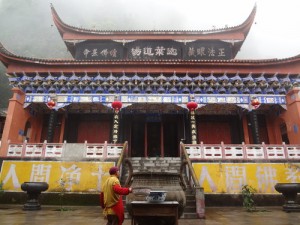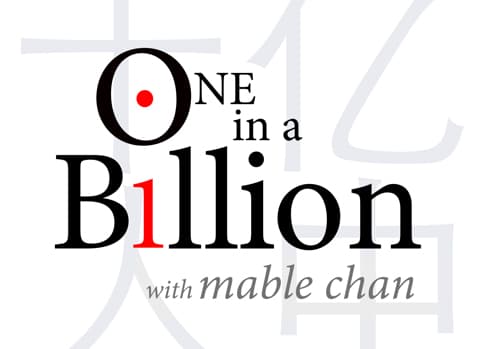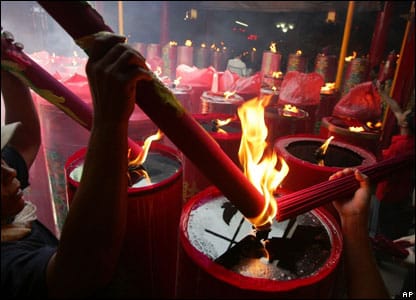Although the journey from Beijing back to my hometown took nearly a day, those hours on the plane passed quickly. It seemed like one moment I was wading through the smoggy soup of gray Beijing air, and the next I was blinking in the bright, hot Texas sunlight. The culture shock was immediately palpable. It seems like it should take longer to travel between two places so different.
Texas is culturally unique even within the United States – especially when it comes to religion. Sprawling cement suburbs and megachurches are indigenous only to certain pockets of America. When I stepped into the huge, air-conditioned church that is the cornerstone of my hometown, I couldn’t help but think how different it was from temples in China.
First, there are the physical disparities. Aside from the largest, most touristy destinations, Chinese temples tend to be small, run-down community affairs. The temple near my apartment in Tianjin was a small, red-walled compound distinguishable only by its ancient carved roof tiles and a small sign on the door. Inside, altars were decorated with fake flowers. Monks shuffled around slowly, sweeping the floor or exercising. In Chinese temples, there’s a culture of being both reverent and casual. People will walk in from the street, wearing their everyday clothes, and take deep bows in front of the deities. They burn incense, close their eyes, and shake their steepled hands. Then they quickly get back to chatting and head back out onto the busy streets.
In contrast, worship in America has a much more rigid culture. In some Southern churches, people come dressed to the nines in starched suits and elaborate hats. In others, the congregation and preacher engage in rhythmic back-and-forth chanting and singing. Churches aside, in all places of worship here there are sermons and sessions where the religious follow a prescribed routine.
But Chinese temples are quiet and laid-back. You can walk in and out as you please. The monks rarely acknowledge your existence as they flow through their daily tasks. Nobody makes announcements or worships together. People are talking, taking pictures, praying, resting.
The roots of religion in Western and Chinese culture, and their impact on modern society, are far beyond anything I could distill into my brief observations. But I do find it fascinating to see how the places of worship differ in their separation from the rest of society. In America, we compartmentalize, zone, and sequester all our actions. Work is separate from play, and then there is the time for exercising and for eating and for sleeping. In China, the boundaries are thinner. People play at work, work while exercising, and worship while shopping. Perhaps it’s just that I don’t understand the boundaries yet. But the feeling there, the feeling that I sometimes miss here, is that of one big, jostling, vivid, diverse community, everyone doing everything all at once.
虽然从北京回老家的旅程花了将近一天,但好在在飞机上,时间很快就过去了。似乎在前一个时刻,我还挣扎在弥漫着灰蒙蒙空气的北京机场,下一刻我就闪耀在德州炽热的阳光中了。文化冲击是那么明显,似乎需要花更多的时间才能来往于这样两个截然不同的地方。
即使在美国,德克萨斯州的文化也是相当独特 – 特别是它的宗教。广阔的水泥墩子和大型教会只能代表一部分美国本土的教堂。当我走进我家乡的那巨大,装着空调的教堂时,我不禁开始思考,它和我见过的中国寺庙有些什么不同。
首先,是物理性质上的差异。除了那些最吸引旅客的旅游圣地,中国的寺庙往往以小和破败的姿态存在社区内。我在天津的公寓附近的那个寺庙就很小,红砖墙,唯一明显的标识只是它古色古香雕塑的屋瓦以及门上小小的雕饰。在寺庙里面,祭坛装饰着假花。僧侣慢慢地走来走去,在扫地亦或是锻炼。在中国的寺庙文化里,虔诚似乎也可以很随意。人们会从街上走进寺庙,穿着自己平常的衣服,并深深在神像面前鞠躬。他们烧香时,闭上双眼,摆动他们合十的双手。结束后他们很快就开始聊天,走回到在繁忙的街道上。
相反在美国,礼拜显得严肃和认真得多。南方的一些教会里,来礼拜的人都衣着靓丽,穿着笔挺的西装和精心制作的帽子。教徒和传教士有节奏地诵经。不止是教会,所有的礼拜场所,礼拜都是严肃的按照预先规定好的条例有条不紊的进行。
但是,中国的寺庙是宁静和悠闲的。你可以随意的进入和离开。僧侣们忙于他们日常的生活,很少在意你的存在。没有人一起发出宣言,或者一起礼拜。在这里,人们聊天,拍照,祈祷,休息。
宗教在西方和中国文化的根源,以及他们对现代社会的影响,远远超出了我能提炼的范围。但我觉得很有意思,去探寻礼拜场所在不同类型的社会是如何的不同。在美国,我们严格划分区域,区别对待我们的每一件事情。工作和娱乐严格区分,锻炼,吃饭和睡觉的时间都是各自存在且独立的。在中国,这种界线往往显得很淡。人们工作的时候可以娱乐,锻炼的时候可以工作,购物的时候可以礼拜。也许是我还没有深刻的体会这些界线,但是我能感觉到,感觉到我会想念这里,这里是一个大的,拥挤的,生动的,多元化的社会,每个人都能在其中同时做自己想做的一切。



